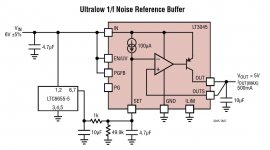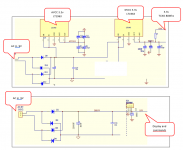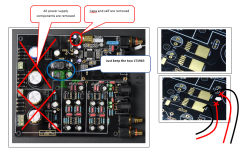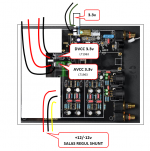As far as noise is concerned the best batteries are indeed -super- low noiseOn the noise question: Right, I think I brought up before that batteries produce some noise. I was assured in an arm-waving sort of way that LifePo4 batteries have very low ESR and therefore should be low noise. To the extent the equivalent circuit model holds, they should be very low-noise. However, I don't know how well the simple model holds and it could be the batteries are more noisy than some may believe.
and very hard to match by active regulators. Sorry can't remember but they
were either NiCad or Li Ion. I think Gerhard did the measurements. A bit of
searching around here should turn up the answer.
We used to use batteries for everything because they just sound very good
but in the end they just proved to be a PITA WRT charging, finite lifetime etc.
zenelectro, Thank you for that info.
The more I think about it I seem to recall some claims that LifePo4 are the new best DAC batteries. I was intending to give them a try but never got around to it with other things going on. Despite possibly being a PITA they may be very useful for comparison purposes to help evaluate the adequacy of one's non-battery operated power supply. For DIY'ers without much test equipment there may be no better relatively low-cost way to know what problems may or may not be caused external power supplies and or on-board regulators. They could help identify problems people had no idea were there. Guess I should get back to working on giving them a try.
The more I think about it I seem to recall some claims that LifePo4 are the new best DAC batteries. I was intending to give them a try but never got around to it with other things going on. Despite possibly being a PITA they may be very useful for comparison purposes to help evaluate the adequacy of one's non-battery operated power supply. For DIY'ers without much test equipment there may be no better relatively low-cost way to know what problems may or may not be caused external power supplies and or on-board regulators. They could help identify problems people had no idea were there. Guess I should get back to working on giving them a try.
Last edited:
Wanted to mention I started reading the LT3045 literature. Since an LT3045 can source 500mA they may indeed be a good choice for AVCC supplies for something like an ES9038PRO. The application circuit that caught my eye as possibly be the best candidate for AVCC use was the ultra-low 1/f noise buffer idea as shown in the diagram below.
It was always the graphs of noise density as a function of frequency that concerned me, and that primarily only at lower frequencies. The low 1/f noise version might take care of those concerns very well, can't say for certain as the application idea didn't show any measurements or performance numbers. One would presumably have some work to do further evaluating of what might be possible. Measurements and listening tests would be needed of course. Maybe a lot to take on for a DIY'er with limited resources. Then again, maybe LifePO4 batteries could useful for comparison.
EDIT: Do see in application notes where it suggests 1/f corner frequency of LT3045 error amplifier might be around 10kHz. Also about what the noise density graphs would suggest. If the corner is up that high, I would sure want to make sure with testing it didn't cause any problems at low audio frequencies for something like AVCC which apparently has no PSRR.
Using LT3045 for something like powering opamp rails would likely be a very different matter, since they do tend to have very good PSRR at LF.
It was always the graphs of noise density as a function of frequency that concerned me, and that primarily only at lower frequencies. The low 1/f noise version might take care of those concerns very well, can't say for certain as the application idea didn't show any measurements or performance numbers. One would presumably have some work to do further evaluating of what might be possible. Measurements and listening tests would be needed of course. Maybe a lot to take on for a DIY'er with limited resources. Then again, maybe LifePO4 batteries could useful for comparison.
EDIT: Do see in application notes where it suggests 1/f corner frequency of LT3045 error amplifier might be around 10kHz. Also about what the noise density graphs would suggest. If the corner is up that high, I would sure want to make sure with testing it didn't cause any problems at low audio frequencies for something like AVCC which apparently has no PSRR.
Using LT3045 for something like powering opamp rails would likely be a very different matter, since they do tend to have very good PSRR at LF.
Attachments
Last edited:
LifePO4 batteries is an interesting solution .
we find 3.2v or 3.3v batteries on ebay but it's difficult to find chargers for 3.2v LifePO4
What are your advices about the use the LifePO4 ....capa , protection ....
Thanks
Serge
LifePo4 can range from 3.2 to 3.3V, so they are really the same.
I have very good result with LifePo4 powering my es9038qtm board, you can see my post above. I am using passive output (via transformer) so I can just use 2 LifePo4, one for the dac and one just for the oscillator (I had to remove an smd choke and connect from there)
since my LifePo4 is industry type 5AH, they can last quite a while.
I use a single cell charger similar to below and clip direct on dac battery when charging (I have a on/off switch for each battery and turn off switch when charging)
Charger for Single LiFePO4 Battery(3.65V/10A)JCSC10 single cell battery charger | eBay
Some of the automatic chargers work with them, such as this one:
Amazon.com: Universal Battery Charger, EASTSHINE S2 LCD Display Speedy Smart Charger for Rechargeable Batteries Ni-MH Ni-Cd AA AAA Li-ion LiFePO4 IMR 10440 14500 16340 18650 RCR123 26650: Electronics
You do have to be careful not to let them discharge too much. From looking at some LifePo4 battery data sheets it looks like you have to stop using them and recharge before they get down to 2volts. There are limits to charging voltage, although don't remember exactly at the moment what the numbers were. If charging them on an automatic charger I would just look to make sure it correctly identifies them and doesn't confuse them with another battery type. Shouldn't be a problem when they are discharged but when fully charged the voltage can be a little higher than normal until a very small amount of discharge. It might be then that a charger could confuse them for a higher voltage battery. The above observations are from watching my own charger with some new batteries. The package the batteries came in said to charge them before use, but they were already charged to the max as it was (although I didn't know it at the time), and more than LifePo4 batteries usually are. I think charger thought they were 3.7v batteries rather than 3.2v so I took them out and decided to ignore the instructions on the package to charge before use. After seeing what happened with the charger, I measured the voltage it was a little above 3.3v, but again don't remember exactly how much more, it might have been 3.35v or so. Same for the other new ones that had not been in the charger even briefly. Apparently it was enough to fool the automatic charger with the first battery I tried. Maybe I should have measured first before following the instructions on the package. At least I took the battery out of the charger pretty quickly, and apparently no damage.
U can kill a LifePo4 if u use the wrong type of charger, definitely not the 3.7V charger mean for a different type of battery. Also don't let the lifepo4 drop below 3v, they are fairly stable above 3v until they are almost depleted. There is a good chance to kill a battery if the voltage drops too low.
I found nice improvement by powering the oscillator using a lifepo4.
BTW, I have an Epson saw 100mhz on order and will replace the stock oscillator later.
Epson saw 100mhz on order and will replace the stock oscillator later.
Why that? Jitter not specified well enough for DAC use, and non-crystal clock sources are usually not as good as crystal for DAC use.
Building the $99 ES9018 DAC Board (Part III) – H i F i D U I N O
Nice results with Epson saw oscillator.
ChuckT please for report. Our dac has similar configuration. Maybe i also try lipo for clock in future.
Nice results with Epson saw oscillator.
ChuckT please for report. Our dac has similar configuration. Maybe i also try lipo for clock in future.
It makes sense to try, but can the solder pads survive 2-3 trials? I am using a Suprene Sound BursonV5 dual opa (60$). The price tag is higher, than the cost of the board byself but that was a very good investment and I think the 100 MHz Crystek makes a good choice as well.
Last edited:
LifePo4 can range from 3.2 to 3.3V, so they are really the same.
I have very good result with LifePo4 powering my es9038qtm board, you can see my post above. I am using passive output (via transformer) so I can just use 2 LifePo4, one for the dac and one just for the oscillator (I had to remove an smd choke and connect from there)
since my LifePo4 is industry type 5AH, they can last quite a while.
[/url]
ChuckT,
Please clarify me, one battery for oscillator and controller and the second one for DAC digital and analog supply ( including toslink - spdif), I am working on something very similar and just want to follow.
It makes sense to try, but can the solder pads survive 2-3 trials?
Don't know if you looked at the $99 ES9018 link, but it was clearly a low-cost all the way project.
OTOH, many people who have purchased the ES9038Q2M board are more interested in modding for best sound quality rather than absolute minimum cost. In fact no mods at all is probably the minimum cost (maybe need to buy a wall wart). So, I would agree if SQ is the goal it probably costs around $200 or a maybe a little more to get this one up to really good SQ.
What about this:
SPXO Crystal Oscillators - Epson Timing | Mouser Hungary
SPXO Crystal Oscillators - Epson Timing | Mouser Hungary
Looking at the 100MHz crystal clocks Mouser stocks it appears Epson only specifies jitter down to 12kHz offset. Also, they don't seem to classify any as low jitter or ulra-low jitter. Can't see any reason in the data sheets to expect them to be good for audio DAC use.What about this:
As observation, the blue boards (all three types on the market), are using a 100R between oscillator and DAC, the green ones just 33R, possibly increased digital residual noise level, just a guess...
Clock data sheets sometimes have a suggested value of series resistor to use with them. Possibly helps isolate load capacitance from pulling on the clock frequency.
Three is a Low noise phone riaa where the built is really nice by FwD. Balanced input all DC coupled RIAA preamp
here the power line is provided with opa usage. Please check if you think interesting would give a chance.
here the power line is provided with opa usage. Please check if you think interesting would give a chance.
Don't know if you looked at the $99 ES9018 link, but it was clearly a low-cost all the way project.
OTOH, many people who have purchased the ES9038Q2M board are more interested in modding for best sound quality rather than absolute minimum cost. In fact no mods at all is probably the minimum cost (maybe need to buy a wall wart). So, I would agree if SQ is the goal it probably costs around $200 or a maybe a little more to get this one up to really good SQ.
Reasonable point.
Please check if you think interesting would give a chance.
Some of the ideas for packaging are very nice. Some of the circuitry is maybe a bit old, with probably some better parts available now. Also, some areas of the circuit design might change due to newer and better components availability. Don't know that there would be a whole lot there for our purposes here.
Hi
A few words about my experience about the power supply . They are not about he ES9038Q2M but same way
I have this dac for several months and i had replaced the OP supply by a SALAS shunt regulator with very good improvements .
I was not really convinced to modify the DAC supply but the different messages made me change my mind
Four pictures to explain the mods.
Picture 1 the original supply
Picture 2 the new supply
Picture 3 the mods
Picture 4 the wiring
The 3.3V regulator for the TXCO is a NewClassD (UWB) Regulator 3.3v The 5v regulator for the display and commands is not important .It is directly connected to the display . I kept the two LT1963 ( they are no so bad !!!!!) and perhaps i will change it
The modifications are not difficult to achieve , not very expensive and the sound improvement is very very significant.
and the sound improvement is very very significant.
I did not have the patience to make the changes one after the other and determine the most important change sorry.
sorry.
Serge
A few words about my experience about the power supply . They are not about he ES9038Q2M but same way

I have this dac for several months and i had replaced the OP supply by a SALAS shunt regulator with very good improvements .
I was not really convinced to modify the DAC supply but the different messages made me change my mind
Four pictures to explain the mods.
Picture 1 the original supply
Picture 2 the new supply
Picture 3 the mods
Picture 4 the wiring
The 3.3V regulator for the TXCO is a NewClassD (UWB) Regulator 3.3v The 5v regulator for the display and commands is not important .It is directly connected to the display . I kept the two LT1963 ( they are no so bad !!!!!) and perhaps i will change it
The modifications are not difficult to achieve , not very expensive
I did not have the patience to make the changes one after the other and determine the most important change
Serge
Attachments
This is the same board that I have coming my way! I was going to initially power the AVCC and DVCC using the LT3042/5 and when I figured out what I would use as possibly an improvement to the AVCC supply, then move a 3042/45 to the clock. My idea that cleaner power will lead to a more stable clock.
As for the LT1963s, I was going to do a comparison of it's performance versus a 3042/45. I see that the data sheet suggests that it is optimized for fast transient response as opposed to the 3042/45 where noise appears to the dominant aspect of its design. We shall see.
On the OPA side, I was going to reuse the original bridge and caps and then take out the 3 term regs and insert a Sulzer Power Supply to replace the regs.
Did you make any modifications to the IV circuit at all?
As for the LT1963s, I was going to do a comparison of it's performance versus a 3042/45. I see that the data sheet suggests that it is optimized for fast transient response as opposed to the 3042/45 where noise appears to the dominant aspect of its design. We shall see.
On the OPA side, I was going to reuse the original bridge and caps and then take out the 3 term regs and insert a Sulzer Power Supply to replace the regs.
Did you make any modifications to the IV circuit at all?
Last edited:
- Home
- Source & Line
- Digital Line Level
- ES9038Q2M Board




